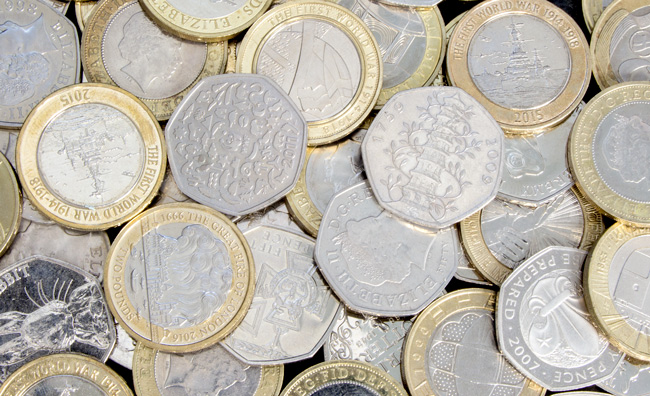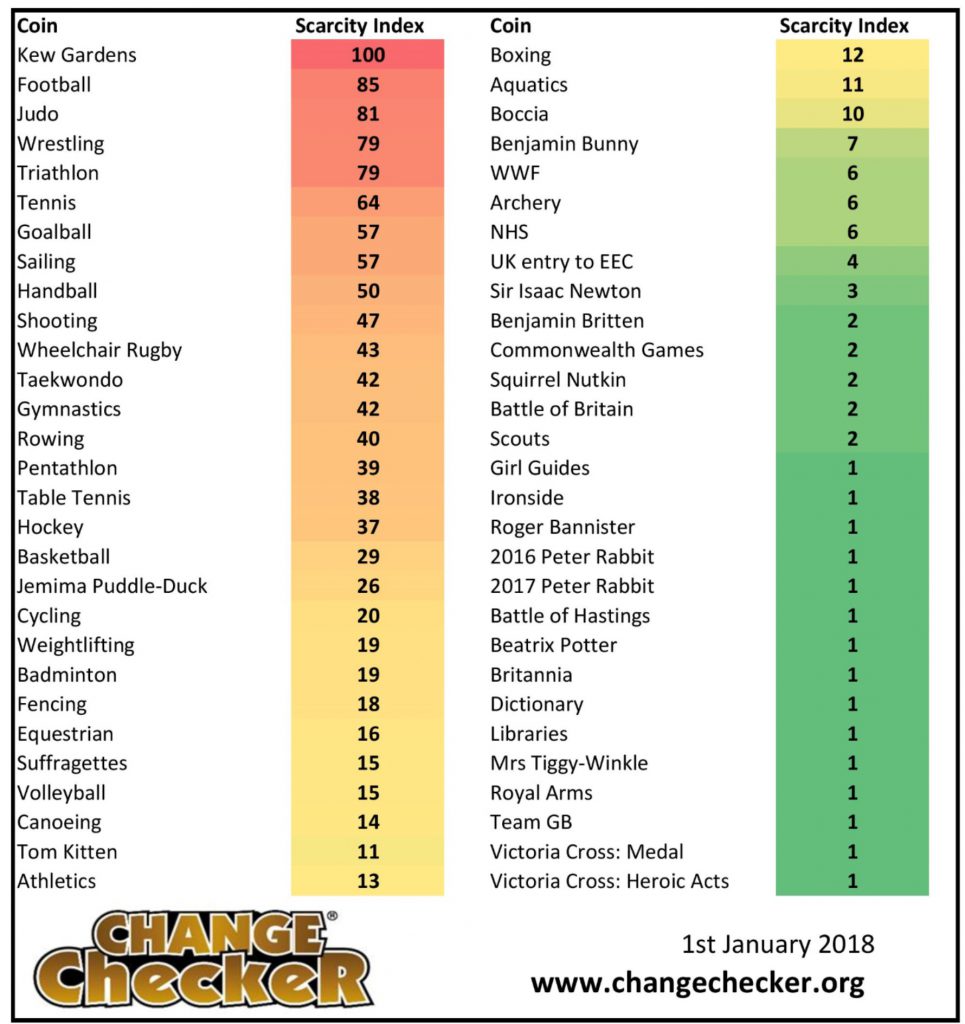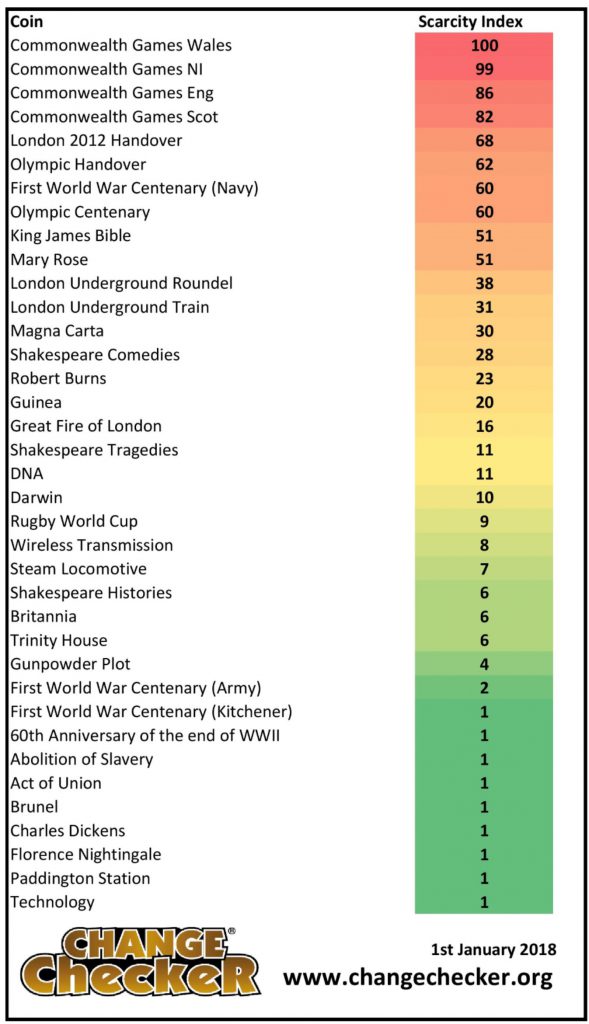Posts Tagged ‘Scarcity Index’
How much is my coin worth? – A five point guide.
How much is my coin worth? It’s a question I’m asked multiple times each day, and with some coins selling for many times their face value, I understand why you’d be keen to know.

The truth is, it’s very hard to tell you exactly what your coin is worth as it depends on so many variants. Coins are no different to any other kind of collectible in many ways; there are certain criteria which you should always look out for, which can help you to determine how collectible or valuable your coin is.
Often it’s a very difficult question to answer but with a little bit of detective work you should be able to work out an accurate value for your coin. I’ve put together some useful tips, in our 5 point guide below, to get you started:
1. Change Checker Scarcity Index
The first place to start is our Change Checker Scarcity Index. I believe this to be the single most accurate way of determining how scarce your coins are. Whilst it doesn’t give you an actual value we know that the value of a coin is directly linked to scarcity.
Historically, when trying to determine the scarcity of a coin, the mintage figure was considered the most accurate indicator. Whilst the mintage figures are undoubtedly important, our Scarcity Index also takes into consideration some very useful data from our Change Checker web app.
We combine the mintage information with two other key pieces of information:
- How many of each design are listed as “collected” by Change Checkers, indicating the relative ease of finding a particular coin.
- The number of times a design has been requested as a swap over the previous 3 months, showing the current level of collector demand.
It’s very simple to work out how scarce your coin is, each coin is given a score out of 100, the higher the score the more scarce that coin is.
2. eBay is best
Once you’ve determined the scarcity of your coin the next step would be to take a look at what has recently sold on eBay. It’s very important that you make sure you look at ‘recently sold’ coins and not just those that have been listed. Essentially, anybody can list a coin on eBay and charge whatever amount they wish.
By checking the recently sold items (and I’d suggest you look at the previous 3-5 coins sold) you will get an accurate indication of what people are willing to pay for a particular coin.

Make sure you look the ‘Sold Listings’ on eBay to check the price people are paying for coins.
Also, if you are looking to sell any coins in your collection, I’d definitely recommend eBay as the easiest, and importantly, the most secure platform to do this.
3. Are your coins still available to buy in BU quality?
Next, it’s worth checking if the coin in your collection is still available to purchase in superior Brilliant Uncirculated quality from an official Royal Mint distributor. If it is still for sale, it’s unlikely that people would purchase a circulation quality coin for the same price.

If Brilliant Uncirculated coins are still available to purchase, it’s unlikely people will buy a circulation quality coin.
If there are no longer any BU coins available to buy, this will work in your favour as collectors will then look for circulation quality coins to add to their collections.
4. Coin condition
It’s definitely worth checking the condition of your coin as this will, almost always, have an effect on the value. It’s no surprise that collectors favour the more pristine coins to those that are showing signs of wear and tear due to circulation.

The condition of your coin will likely affect its value.
However, your coin’s condition is not the be all and end all; it’s very rare to find a circulation 2002 Commonwealth Games £2 coin in good condition yet these sell for many times their face value.
5. Is there a story?
This can often tie-in with rarity, as the coins with a good story behind them tend to be the ones which are difficult to get your hands on! The “undated 20p” is a recent example of a such a coin. It is known as a ‘mule’ – a coin with a mismatched obverse and reverse (heads and tails). The name derives from a mule being the hybrid offspring of a horse and donkey.

The ‘undated 20p’ generated a huge amount of media coverage resulting in coins selling for many times their face value.
In 2008 when the reverse of the 20p coin changed to the new Royal Shield design, approximately 100,000 coins were accidentally struck with the previous obverse die and therefore there was no date on the coin.
In a similar way to the Kew Gardens story, some of the prices being quoted as a result of media coverage were extraordinary. Mules are highly sought after by collectors, and an undated 20p will certainly be worth more than its face value in years to come.
It’s always good to remember that if your coin is legal tender, it will always be worth at least its face value.The good news…
That’s why I think change collecting is the best hobby you could have!
If you’re interested in coin collecting, our Change Checker web app is completely free to use and allows users to:
– Find and identify the coins in their pocket
– Collect and track the coins they have
– Swap their spare coins with other Change Checkers

Sign up today at: www.changechecker.org/app
2017 Quarter 4 Change Checker “Scarcity Index” Released
Following the launch of the Change Checker “Scarcity Index” early last year, the final 2017 Quarter 4 Index has now been published.
50p Scarcity Index

It’s of little surprise that Kew Gardens maintains its top spot as the UK’s most sought after circulation coin with a perfect score of 100.
The mintage figures for the 2017 50p coins were released just before Christmas and have had an effect on the Scarcity Index scores. Interestingly, the Sir Isaac Newton 50p only scores a 3/100 which is lower than we anticipated. This is mainly due to the large number of Change Checkers who list having the coin in their collection. However, we are expecting this score to increase during the next quarter due to the low mintage figure, of just 1.8 million, driving demand.
Jemima Puddle-Duck remains the most scarce Beatrix Potter 50p, with Tom Kitten and Benjamin also scoring quite highly with a score of 13 and 7 respectively. Tom Kitten and Benjamin Bunny were only released into circulation in December so requests for swaps are high. Mintage figures for these coins are also relatively high so as more people find these coins in their change it is possible these scores will decrease slightly.
Interestingly, the mintage figure for the Jeremy Fisher 50p coin has been released, however the coin is not yet in circulation.
£2 Scarcity Index

There’s not a lot of movement in our Quarter 4 £2 “Scarcity Index” update.
The Commonwealth Games Wales £2 coin takes top spot from the Commonwealth Games Northern Ireland. This is down to the very large number of swap requests for this coin in the last quarter. At 99/100 the Northern Ireland coin is still very scarce (as are the other two coins in the Commonwealth Games series) and it’s very possible it will retake the number 1 spot next quarter.
We are still waiting for the Jane Austen and WWI Aviation £2 coins to be released into circulation, hence why they do not feature on our Index. We await the release of these and their mintage figures with great interest, could they be low like the Sir Isaac Newton 50p? It is possible.
How the Scarcity Index works
Generally collectors have had to rely upon mintage figures to identify the scarcest coins. But they only tell part of the story. Trying to find a good quality coin from 15 – 20 years ago, even for a higher mintage issue, is much more challenging than a more recent issue, as coins become damaged over time and are ultimately removed from circulation.
Additionally, some designs are more hoarded than others by people who might not normally collect coins – the recent poignant First World War £2 Coin series being an example. Finally, it can be up to a couple of years before the Royal Mint eventually confirms the actual mintage for an issue.
That’s why we have combined the mintage information with two other key pieces of information.
- How many of each design are listed as “collected” by Change Checkers, indicating the relative ease of finding a particular coin.
- The number of times a design has been requested as a swap over the previous 3 months, showing the current level of collector demand.
Importantly, as new coins are released and popularity rises and falls across different designs the Scarcity Index will be updated quarterly allowing Change Checkers to track the relative performance of the UK’s circulation coins.
How much are my coins worth?
The Scarcity Index does not necessarily equate to value but it is certainly an effective indicator. For example, the Kew Gardens 50p coin commands a premium of up to 160 times face value on eBay.
What about £1 Coins?
The £1 Scarcity Index has already been published for the Round £1 coins and, because they are no longer being issued, this is now set in stone.
2017 Quarter 3 Change Checker “Scarcity Index” Released
Following the launch of the Change Checker “Scarcity Index” earlier this year the Quarter 3 Index has now been published.
50p Scarcity Index

It’s of little surprise that Kew Gardens maintains its top spot as the UK’s most sought after circulation coin with a perfect score of 100.
Isaac Newton, which made it’s debut in our Q2 update, settles on a score of 15, dropping 8 points from 23. This is due to a higher than expected number of Change Checker’s having this coin in their collection.
The 2017 Peter Rabbit 50p joins the “Scarcity Index” after having been released into general circulation at the end of September. A score of 16 makes it the 2nd scarcest Beatrix Potter 50p.
It’s worth noting that we currently only have estimated mintages for these two coins; it’ll be interesting to see how they rank once official mintage figures are released.
£2 Scarcity Index

There’s not a lot of movement in our Quarter 3 £2 “Scarcity Index” update.
Commonwealth Games Northern Ireland regains its position at the top of the table after being briefly replaced by Commonwealth Games Scotland in Q2.
The overall value of the Commonwealth games series has dropped slightly, however these 4 coins are still some way clear of the London 2012 Handover in 5th place.
There are no new £2 coins to add to the Index as we’re still waiting for the Jane Austen and WWI Aviation coins to be released into general circulation. We expect this to happen in Q4.
How the Scarcity Index works
Generally collectors have had to rely upon mintage figures to identify the scarcest coins. But they only tell part of the story. Trying to find a good quality coin from 15 – 20 years ago, even for a higher mintage issue, is much more challenging than a more recent issue, as coins become damaged over time and are ultimately removed from circulation.
Additionally, some designs are more hoarded than others by people who might not normally collect coins – the recent poignant First World War £2 Coin series being an example. Finally, it can be up to a couple of years before the Royal Mint eventually confirms the actual mintage for an issue.
That’s why we have combined the mintage information with two other key pieces of information.
- How many of each design are listed as “collected” by Change Checkers, indicating the relative ease of finding a particular coin.
- The number of times a design has been requested as a swap over the previous 3 months, showing the current level of collector demand.
Importantly, as new coins are released and popularity rises and falls across different designs the Scarcity Index will be updated quarterly allowing Change Checkers to track the relative performance of the UK’s circulation coins.
How much are my coins worth?
The Scarcity Index does not necessarily equate to value but it is certainly an effective indicator. For example, the Kew Gardens 50p coin commands a premium of up to 160 times face value on eBay.
What about £1 Coins?
The £1 Scarcity Index has already been published for the Round £1 coins and, because they are no longer being issued, this is now set in stone.

